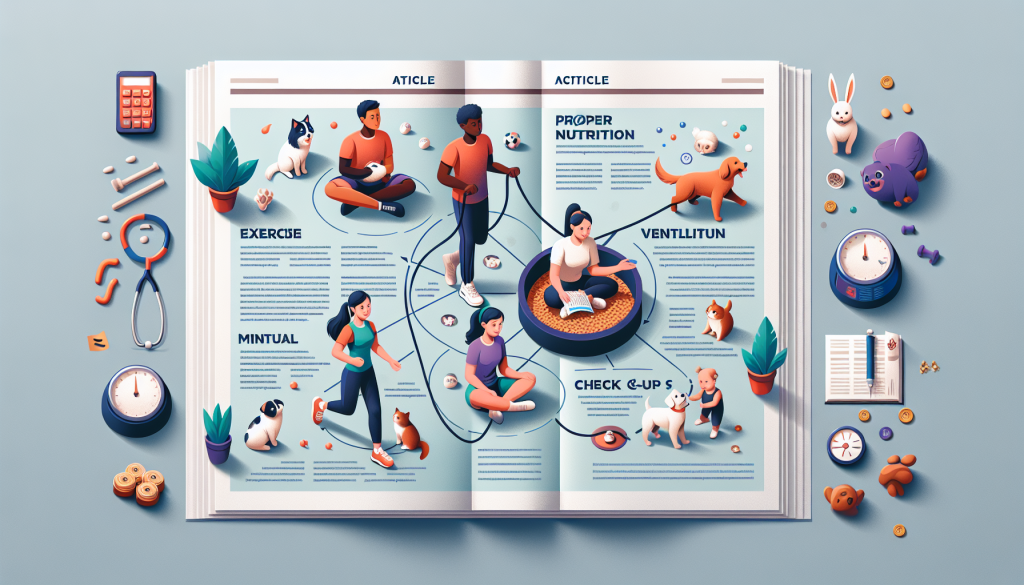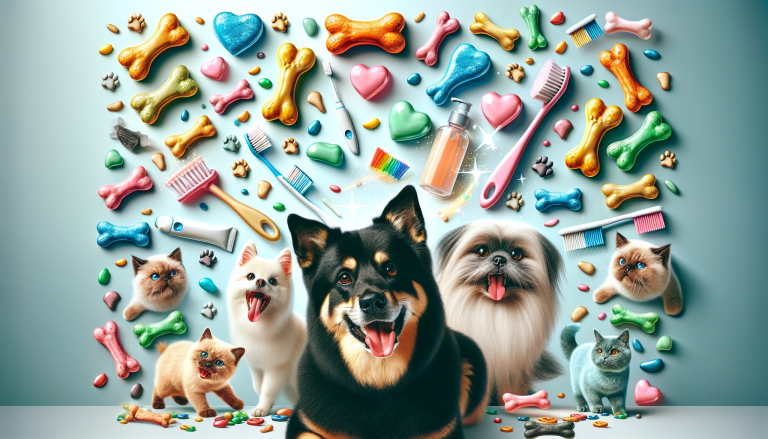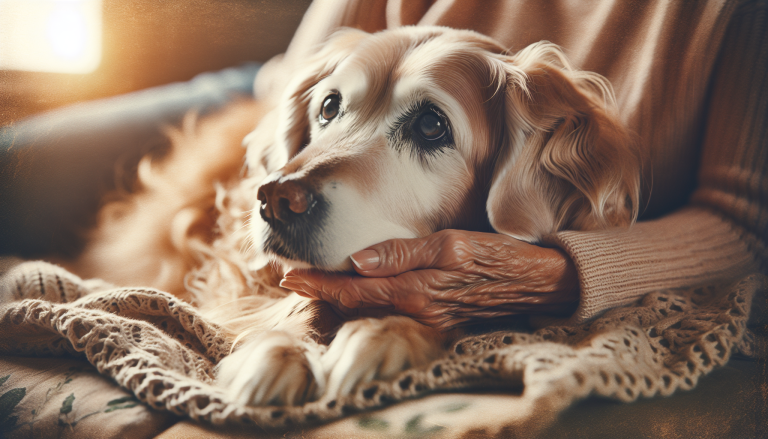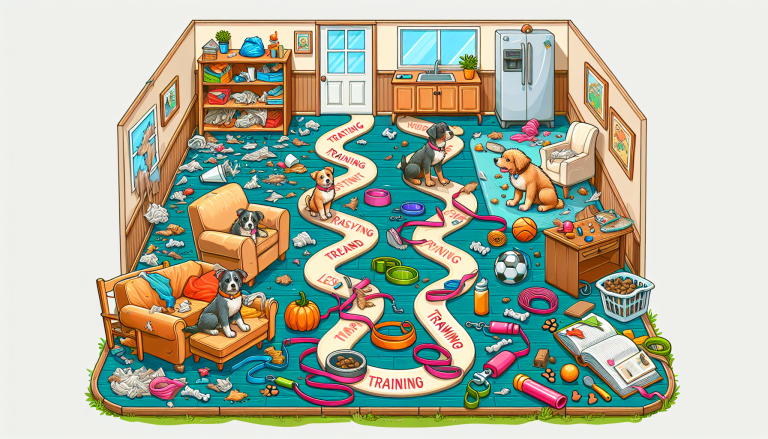Whether you have a furry feline friend or a lovable canine companion, keeping your pet happy and healthy is of the utmost importance. From providing them with a balanced diet and regular exercise to ensuring they receive proper veterinary care, there are several key ways to ensure your pet’s wellbeing. In this article, we will explore the best methods for keeping your pet happy and healthy, so you can enjoy years of companionship and unconditional love together.
Table of Contents
ToggleProper Nutrition
Provide a balanced diet
When it comes to keeping your pet happy and healthy, providing a balanced diet is essential. Just like humans, pets require a well-rounded combination of nutrients to thrive. Make sure their diet includes a variety of proteins, carbohydrates, fats, vitamins, and minerals. Consulting with a veterinarian or a pet nutritionist can help you determine the specific dietary needs of your pet based on their age, breed, and activity level.
Choose high-quality pet food
The quality of the pet food you choose plays a significant role in your pet’s overall health. Opt for reputable brands that prioritize natural ingredients and avoid artificial additives or fillers. Look for pet food that meets or exceeds the nutritional guidelines set by the Association of American Feed Control Officials (AAFCO). Reading labels and doing some research can ensure that you provide your pet with the best possible nutrition.
Feed the right amount
Feeding your pet the right amount of food is just as important as providing a balanced diet. Each pet has unique caloric requirements, so consult with a veterinarian to determine the appropriate portion sizes for your furry friend. Overfeeding can lead to obesity and various health issues, while underfeeding can result in malnutrition. It’s important to regularly monitor your pet’s weight and adjust their food intake accordingly.
Consider age-specific nutrition
As your pet ages, their nutritional needs may change. Puppies and kittens require more calories, protein, and essential nutrients to support their growth and development. Adult pets need a well-rounded diet to maintain their health and vitality. Senior pets may benefit from specialized diets that cater to their aging bodies and specific health conditions. Keep in mind that providing age-appropriate nutrition can contribute to your pet’s overall well-being and longevity.
Offer fresh water
Hydration is key to maintaining your pet’s health. Always ensure that your pet has access to fresh, clean water throughout the day. Monitor their water bowl and refill it regularly, especially during hot weather or if your pet is particularly active. Dehydration can lead to serious health issues, so make sure your pet has ample hydration to stay happy and healthy.
Regular Exercise
Engage in daily physical activities
Just like humans, pets need regular exercise to stay fit, burn off excess energy, and maintain a healthy weight. Make it a priority to engage in daily physical activities with your pet. Whether it’s playing fetch, going for a jog, or engaging in a game of tag, find activities that your pet enjoys and incorporate them into your daily routine. Not only will it benefit their physical health, but it will also strengthen the bond between you and your furry companion.
Take your pet for walks
Walking is an excellent form of exercise for both dogs and cats. It allows them to explore their surroundings, stimulate their senses, and get some fresh air. Dogs, in particular, thrive on daily walks as it provides mental and physical stimulation. Make it a habit to take your dog for regular walks, and if you have a cat, consider harness training them for supervised outdoor adventures.
Play interactive games
Playtime is more than just fun for your pet; it’s a crucial part of their overall well-being. Engaging in interactive games like tug-of-war, hide-and-seek, or puzzle toys can help keep your pet mentally stimulated and physically active. These activities not only provide exercise but also enhance their problem-solving skills and cognitive abilities. Remember to choose age-appropriate toys and games that promote safe and enjoyable playtime.
Provide mental stimulation
Pets, especially intelligent breeds, require mental stimulation to prevent boredom and destructive behaviors. Incorporate activities that challenge their minds, such as treat-dispensing toys or food puzzles. Teaching them new tricks or commands can also stimulate their intellect. Keeping their minds active and engaged will contribute to their overall happiness and reduce the likelihood of behavioral issues.
Consider their breed and size
When planning exercise routines for your pet, it’s crucial to consider their breed and size. Some dog breeds require more vigorous exercise and activities due to their high energy levels, while others may need gentler activities. On the other hand, smaller dog breeds may have different exercise requirements compared to larger breeds. Consult with a veterinarian or a professional dog trainer to tailor your pet’s exercise routine to their individual needs.
Routine Veterinary Care
Schedule regular check-ups
Regular veterinary check-ups are essential for maintaining your pet’s health and detecting any potential issues early on. Schedule annual wellness exams for your pet, or more frequently for senior pets or those with existing health conditions. During these exams, your veterinarian will perform a thorough physical examination, update vaccinations, and address any concerns you may have. Regular check-ups allow for proactive healthcare and ensure that your pet receives appropriate medical attention throughout their life.
Keep up with vaccinations
Vaccinations play a crucial role in protecting your pet against various infectious diseases. Consult with your veterinarian to create a vaccination schedule that aligns with your pet’s lifestyle and potential exposure risks. Core vaccinations, such as rabies and distemper, are generally recommended for all pets, while additional vaccines may be necessary based on your pet’s individual needs. Keeping up with vaccinations will help prevent the spread of diseases and keep your pet in optimal health.
Prevent flea and tick infestations
Fleas and ticks can cause discomfort and transmit diseases to your pet. Implement a regular flea and tick prevention regimen as recommended by your veterinarian. Options include spot-on treatments, oral medications, collars, or topical solutions. Regularly inspect your pet’s fur for any signs of fleas or ticks, especially after spending time outdoors. Promptly address any infestations and consult with your veterinarian about the most effective prevention methods for your pet.
Maintain dental hygiene
Oral health is an often overlooked aspect of pet care, but it is crucial to your pet’s overall well-being. Poor dental hygiene can lead to dental disease, which can cause pain, discomfort, and even organ damage. Incorporate regular teeth brushing into your pet’s routine, using a specially formulated pet toothpaste and a soft-bristled toothbrush. Additionally, provide dental chews or toys that promote chewing and help keep your pet’s teeth clean. Regular dental check-ups and professional cleanings may also be necessary to maintain optimal oral health.
Address any health concerns promptly
Pay close attention to any changes in your pet’s behavior, appetite, or appearance, as these could be signs of an underlying health issue. If you notice anything unusual, don’t hesitate to consult with your veterinarian. Promptly addressing health concerns can prevent them from escalating into more serious conditions. Remember, you are your pet’s advocate, and regular communication with your veterinarian is vital for their continued well-being.
Grooming and Hygiene
Brush your pet regularly
Regular brushing helps maintain your pet’s coat health and prevents matting, tangling, and shedding. It also stimulates their skin, improves circulation, and allows you to check for any abnormalities or parasites. Choose a brush or comb suitable for your pet’s coat type and establish a grooming routine that works for both of you. Not only will regular brushing keep your pet’s coat looking great, but it will also strengthen the bond between you and your furry friend.
Bathe them when necessary
While some pets require frequent baths, others may need them less often. Bathe your pet only when necessary, using a pet-specific shampoo that is gentle on their skin and fur. Over-bathing can strip their coat of essential oils and lead to dryness or irritation. When bathing, ensure proper rinsing to prevent any residue that may cause itchiness. Remember to dry your pet thoroughly, especially their ears, to avoid moisture-related issues.
Trim nails and clean ears
Regular nail trims are essential to prevent discomfort, pain, or injury. Trim your pet’s nails using a pet-specific nail trimmer, taking care not to cut the quick. If you are unsure or uncomfortable with nail trimming, consult a professional groomer or veterinarian. Additionally, maintain your pet’s ear hygiene by regularly cleaning their ears using a veterinarian-approved ear cleaning solution. This will help prevent ear infections and remove any build-up of wax or debris.
Maintain a clean living environment
A clean living environment is crucial for your pet’s overall health and well-being. Regularly clean their bedding, toys, and any areas they frequently occupy to minimize the risk of bacteria or parasites. Vacuum or sweep floors to remove pet hair and dander, which can trigger allergies or respiratory issues. If you have a litter box, clean it daily to prevent unpleasant odors and ensure your cat’s comfort.
Regularly check for signs of parasites or skin issues
Fleas, ticks, mites, and other parasites can cause discomfort and lead to health problems for your pet. Regularly inspect your pet’s fur and skin for any signs of parasites or skin issues, such as redness, rashes, lumps, or bald patches. If you notice anything unusual, consult with your veterinarian for appropriate treatment options. Timely detection and treatment can prevent these issues from escalating and negatively impacting your pet’s health.
Socialization and Mental Stimulation
Expose your pet to different environments
Socializing your pet from a young age is crucial for their overall well-being and behavior. Expose them to various environments, such as parks, busy streets, and different types of locations. This exposure helps them become accustomed to different sights, sounds, and smells, reducing the likelihood of fear or anxiety in new situations. Gradually introduce new experiences to their routine, ensuring positive reinforcement to create a confident and well-adjusted pet.
Introduce them to various people and animals
Allowing your pet to interact with different people and animals is essential for their social development. Introduce them to family members, friends, and other pets in a controlled environment, emphasizing positive interactions. This exposure helps prevent fear or aggression towards unfamiliar individuals or animals. Encourage friendly and gentle behavior, and always supervise these interactions to ensure the safety and comfort of everyone involved.
Allow time for social interaction
Pets thrive on social interaction, whether it’s with their human family members or other animals. Set aside dedicated time each day for one-on-one playtime or cuddles with your pet. If you have multiple pets, ensure they have opportunities to interact and engage in playful activities together. This socialization not only provides companionship for your pet but also strengthens your bond with them.
Provide toys and games for mental stimulation
To keep your pet’s mind sharp and engaged, provide them with a variety of toys and games that offer mental stimulation. Puzzle toys, treat-dispensing toys, and interactive games can help satisfy their natural curiosity and challenge their problem-solving abilities. Rotate their toys regularly to prevent boredom and explore new ways to interact with them. Engaging your pet in mentally stimulating activities can prevent destructive behavior and provide a healthy outlet for their energy.
Consider obedience training or puzzle toys
Obedience training is an excellent way to provide mental stimulation while reinforcing positive behavior in your pet. Teach them basic commands such as sit, stay, or come, using positive reinforcement techniques like treats or praise. Training not only promotes good behavior but also enhances the bond between you and your pet. Puzzle toys can also offer mental stimulation, as they require your pet to figure out how to access hidden treats or toys. Both obedience training and puzzle toys can contribute to a happy and mentally sharp pet.
Safe and Comfortable Living Space
Provide a designated resting area
Just like humans, pets need a designated resting area where they can retreat and relax. Provide a comfortable bed or a cozy blanket in a quiet and peaceful corner of your home. This space should be away from excessive noise, foot traffic, or any potential stressors. Having a dedicated resting area allows your pet to feel safe and secure, promoting relaxation and better overall well-being.
Ensure proper temperature and ventilation
Maintaining a suitable temperature and good ventilation in your pet’s living space is crucial for their comfort and health. Extreme temperatures can be detrimental to your pet, so make sure they have access to a cool area in hot weather and warmth during colder months. Ensure proper air circulation to prevent stuffiness or the buildup of allergens. Pay attention to signs of discomfort, such as excessive panting or shivering, and adjust the environment accordingly.
Baby-proof the house
If you have a pet, it’s essential to make your home safe and pet-proof, much like baby-proofing for a child. Remove any potentially dangerous items or substances that your pet may accidentally ingest or get injured by. Secure loose cords, electrical outlets, and hazardous chemicals out of reach. Additionally, secure any small objects that could be choking hazards. Providing a safe living environment will give you peace of mind and prevent accidents or injuries.
Keep toxic substances out of reach
Pets are naturally curious, and some substances that are harmless to humans can be toxic to them. Keep medications, cleaning products, and poisonous plants out of your pet’s reach. Secure garbage cans and recycling bins to prevent them from accessing potentially hazardous materials. Familiarize yourself with the common household items that are toxic to pets and take necessary precautions to ensure their safety.
Avoid excessive noise or chaotic environments
Pets can be sensitive to loud noises or chaotic environments, which can cause stress or anxiety. Avoid subjecting your pet to excessive noise, such as loud music, vacuum cleaners, or fireworks. If you have guests or a busy household, provide a safe and quiet space where your pet can retreat if they feel overwhelmed. Reducing stressors and providing a calm environment will contribute to your pet’s overall well-being.
Love and Affection
Spend quality time with your pet
Pets thrive on companionship and enjoy spending quality time with their human family. Make it a priority to devote dedicated time each day for bonding activities with your pet. This can include playing, cuddling, or simply being present and engaging in their favorite activities. Regular interaction and quality time will strengthen your emotional connection and ensure that your pet feels loved and secure.
Show them physical affection
Like humans, pets appreciate physical affection as a form of love and reassurance. Petting, cuddling, or gentle massages can help reduce anxiety and promote relaxation in your pet. Pay attention to their body language and respect their comfort level. Some pets may enjoy belly rubs, while others prefer head scratches. Discover what your pet enjoys and use physical affection as a way to express your love and care for them.
Speak in a soothing and comforting tone
Pets are sensitive to the tone of voice used when communicating with them. Speak to your pet in a soothing and comforting tone, using gentle and positive words. This helps create a sense of security and understanding for your pet. Avoid using harsh or loud tones, as this can trigger fear or anxiety. Consistent positive communication will foster a loving and trusting relationship with your furry friend.
Provide a sense of security and companionship
Pets rely on their human family members for a sense of security and companionship. Ensure that your pet feels safe and protected in your presence. Establish routines and rituals that provide a sense of familiarity and predictability. Being consistent and reliable in your interactions and care will help your pet feel secure and confident. Show them that they are an important part of your family and that they have a loving and stable home.
Offer praise and positive reinforcement
Positive reinforcement is a powerful tool in shaping your pet’s behavior and strengthening the bond between you. Praise your pet for good behavior, whether it’s following a command, using the litter box, or exhibiting calmness in a stressful situation. Reward them with treats, toys, or affection to reinforce their positive behavior. Consistency and positive reinforcement create a positive and trusting environment for your pet.
Proper Identification and Safety Measures
Use proper identification tags or microchips
Proper identification is crucial in case your pet ever gets lost or accidentally wanders away from home. Ensure that your pet wears identification tags with their name, your contact information, and any relevant medical information. Microchipping is also highly recommended, as it provides a permanent form of identification that cannot be lost or removed. Register your pet’s microchip with a reputable database and keep your contact details up to date.
Keep your pet on a leash or in a secure enclosure
When outside of your home, always keep your dog on a leash or in a secure enclosure to prevent accidents or potential loss. Even the most well-behaved dogs can get distracted or startled by unexpected sounds or movements. A leash or enclosed area provides a physical barrier and ensures that your pet stays safe and within your control. This applies to cats as well, as they should be supervised and contained when outdoors.
Train them to respond to basic commands
Teaching your pet basic commands is not only beneficial for their safety but also for their overall obedience and behavior. Teach them commands such as “sit,” “stay,” or “come” to ensure that they respond appropriately when needed. This training provides structure and control, allowing you to navigate potentially dangerous situations with ease. Consistency and positive reinforcement are key to successful obedience training.
Be cautious of potential hazards in your surroundings
Being aware of potential hazards in your surroundings is crucial to your pet’s safety. Keep an eye out for toxic plants, open windows or balconies, swimming pools, or any other potential dangers that your pet may encounter. Secure gates, fences, and doors to prevent your pet from wandering into unsafe areas. Always supervise outdoor activities to ensure that your pet stays vigilant and protected.
Prepare for emergencies or natural disasters
Being prepared for emergencies or natural disasters is an essential part of responsible pet ownership. Have an emergency kit ready with essential supplies such as food, water, medications, and a first aid kit. Keep a list of emergency contacts, including your veterinarian and local animal shelters. Have a plan in place for evacuation or sheltering in case of emergencies. Being well-prepared ensures the safety and well-being of your pet during challenging times.
Adequate Rest and Sleep
Ensure a comfortable sleeping area
Adequate rest and sleep are vital for your pet’s health and well-being. Provide a comfortable sleeping area that suits your pet’s size and preferences. This can be a cozy bed, a cushioned mat, or a designated area with soft bedding. Consider your pet’s sleeping habits, whether they prefer a secluded spot or enjoy being near you. Creating a comfortable sleeping area ensures that your pet gets the rest they need to stay happy and healthy.
Establish a consistent sleep routine
Pets, like humans, thrive on routine. Establish a consistent sleep routine for your pet by designating specific sleep and wake-up times. Regularity in their sleeping patterns helps regulate their internal clock and promotes better sleep quality. Stick to a schedule as closely as possible, even on weekends or during vacations. Consistency and routine contribute to better overall health and better-adjusted behavior in your pet.
Allow for uninterrupted rest
Ensure that your pet has a quiet and peaceful environment for uninterrupted rest. Minimize noise, distractions, or any potential disruptions during their sleep. Provide a private and comfortable space where they can retreat and sleep without disturbances. This uninterrupted rest is essential for their physical and mental well-being, allowing them to recharge and be ready for their daily activities.
Consider your pet’s age and individual needs
As with humans, the amount of rest and sleep needed can vary based on age and individual needs. Puppies and kittens require more sleep and frequent naps to support their growth and development. Adult pets generally need around 12-14 hours of sleep each day, while senior pets may sleep even more. Pay attention to your pet’s behavior and energy levels to determine if they require any adjustments to their sleep routine.
Provide a quiet and peaceful environment
Creating a quiet and peaceful environment is essential for your pet’s rest and sleep. Reduce excessive noise from electronics, loud conversations, or other sources that can disrupt their sleep. Consider utilizing white noise or soothing music to drown out environmental noise if necessary. A tranquil environment contributes to better quality sleep, beneficial for your pet’s overall health and well-being.
Monitoring and Attention to Behavior
Observe any changes in behavior or appetite
Being attentive to your pet’s behavior and appetite is essential for early detection of any health concerns. Pay close attention to changes in their eating or drinking habits, as well as changes in their activity levels or behavior. Sudden changes could be indicative of underlying health conditions that require prompt veterinary attention. Regularly monitoring your pet’s behavior allows you to address any issues promptly and ensure their continued well-being.
Address anxiety or stress-related issues
Anxiety and stress can have a profound impact on your pet’s behavior and well-being. Some common signs of anxiety or stress in pets include increased vocalization, changes in appetite, excessive grooming, aggression, or withdrawal. If you notice any of these signs, consult with a veterinarian or a professional animal behaviorist for guidance. Addressing anxiety or stress-related issues promptly can help your pet feel more comfortable and lead to healthier behavior.
Encourage positive behavior through training
Positive behavior should be reinforced and encouraged through training techniques that focus on reward-based methods. Teach your pet basic commands, such as “sit,” “stay,” or “leave it,” using positive reinforcement like treats, praise, or toys. This helps strengthen the bond between you and your pet while promoting desirable behaviors. Seek professional help if needed, especially for more complex training or behavioral issues.
Seek professional help if necessary
If you are experiencing challenges with your pet’s behavior or suspect an underlying health concern, don’t hesitate to seek professional help. Consult with a veterinarian, animal behaviorist, or certified dog trainer who can provide expert guidance and support. Seeking professional help ensures that you receive accurate advice tailored to your pet’s specific needs, addressing any issues effectively and promoting their overall well-being.
Be aware of signs of pain or discomfort
Pets, like humans, cannot always communicate when they are in pain or discomfort. Being aware of the signs can help you identify potential health issues. Look out for changes in their movement patterns, reluctance to participate in activities they once enjoyed, increased irritability, or changes in appetite. If you suspect that your pet may be experiencing pain or discomfort, consult with your veterinarian for an evaluation and appropriate treatment options.
In conclusion, providing proper nutrition, regular exercise, routine veterinary care, grooming and hygiene, socialization and mental stimulation, a safe and comfortable living space, love and affection, proper identification and safety measures, adequate rest and sleep, and monitoring and attention to behavior are all crucial for keeping your pet happy and healthy. By following these guidelines and giving your furry friend the love and care they deserve, you can ensure that they live a long, fulfilling, and joyful life as a cherished member of your family.








